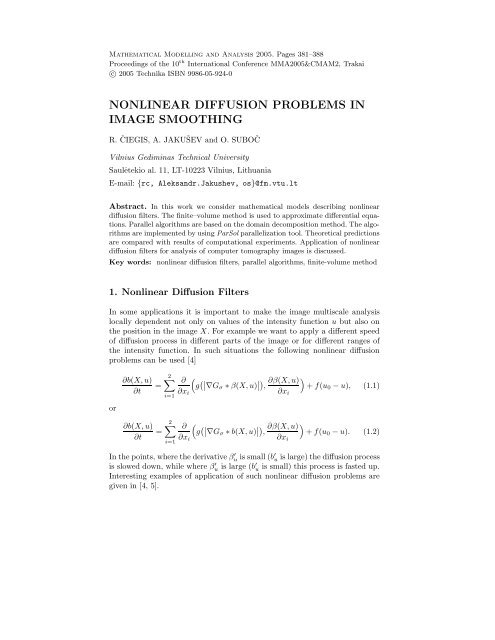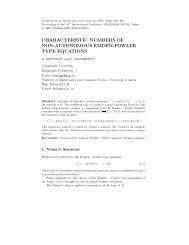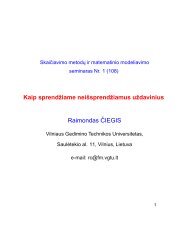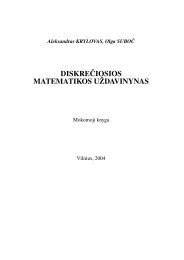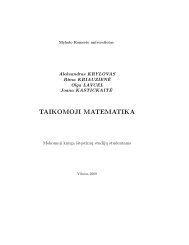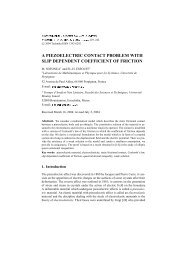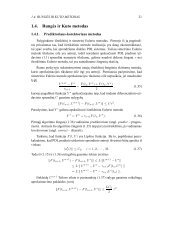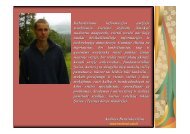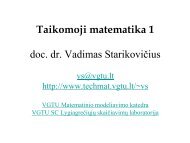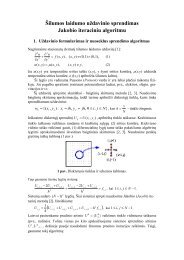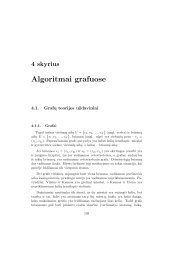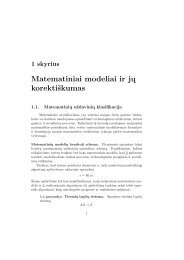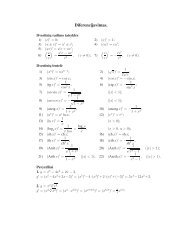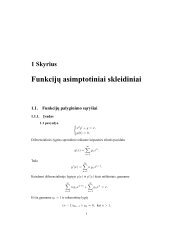NONLINEAR DIFFUSION PROBLEMS IN IMAGE SMOOTHING
NONLINEAR DIFFUSION PROBLEMS IN IMAGE SMOOTHING
NONLINEAR DIFFUSION PROBLEMS IN IMAGE SMOOTHING
Create successful ePaper yourself
Turn your PDF publications into a flip-book with our unique Google optimized e-Paper software.
Nonlinear Diffusion Algorithms for Image Smoothing 3833. Parallel AlgorithmsThe major difficulty in using parallel computers, however, is that writinga parallel program (or parallelizing existing sequential codes), requires theknowledge of special methods and tools, which is not trivial to be mastered[6]. A possibility to improve this situation is the creation of tools to simplifythe parallelization of algorithms. We have developed a new tool, which can beused for semi–automatic parallelization of data parallel algorithms, that areimplemented in C++.3.1. Parallel array objectsThe aim of ParSol is to bring HPF parallelization simplicity to C++language,using popular parallelization standards. Hence, the current ParSol libraryfeatures are:• Created for C++ programming language;• Based on HPF ideology;• The library heavily uses such C++ features as OOP and templates;• Only standard C/C++ features are used;• Currently, MPI 1.1 standard is used to implement parallelization [?, 8];• ParSol currently is open source library.At present, ParSol may be used for parallelization of data–parallel ordomain–decomposition algorithms.ParSol structure and usagePS_CmArray< ElemType, DimCount >PS_CustomTopologyPS_1DTopologyPS_CmArray_2D< ElemType >PS_CmArray_1D< ElemType >…PS_CmArray_3D< ElemType >PS_ParArray< ElemType,DimCount >PS_2DTopologyPS_3DTopology…PS_ParArray_1DPS_ParArray_2DPS_ParArray_3D…Figure 1. ParSol library class diagram.ParSol class diagram is shown in Fig. 1. The main elements of the libraryare:
384 R. Čiegis, A. Jakušev, O. SubočParallel array classes.If parallel arrays are to be used in place of sequential ones, it is natural tomake them to be descendants of appropriate sequential arrays, adding parallelizationcode to the sequential array functionality. However, parallelization issimilar for different kinds of arrays. So parallelization code is localized in classPS ParArray, and is used in parallel array classes by multiple inheritance.Parallelization.A general schema for construction of data parallel algorithms consists of thefollowing steps:1. Determine the part of sequential array that belongs to the given process;2. Determine the neighbour processes that will participate in informationexchange;3. Determine the amount of data to be exchanged with every neighbourprocess;4. Exchange information with neighbours, when required.Stencil classes.A stencil is determined depending on requirements of the computationalscheme. Based on stencil, different amount of information needs to be exchangedamong neighbours. This part of data is required for parallel arraysto operate properly.To use ParSol, a programmer must develop his/her sequential applicationin the same way as without ParSol, only using ParSol arrays wherever computationaldata is stored. The other requirements are to specify the stencil,make algorithm independent on the order in which array points are processedand use global array operations provided by ParSol wherever possible. Thelast one may also be called an advantage, because it frees programmer fromimplementation of simple tasks, allowing to concentrate on problem solving,and makes code cleaner.The parallelization of such a sequential program takes the following steps:1. Replace includes of sequential headers with parallel ones, for examplePS CommonArray.h to PS ParallelArray.h;2. Replace sequential classes with their parallel analogy in variable declarationsonly;3. Add MPI initialization code (one line at the beginning of the program);4. Add topology initialization code (in its simplest case, one line at the beginningof the program);5. Specify when array neighbours should exchange data.Finally, MPI library should be linked during a building process.
Nonlinear Diffusion Algorithms for Image Smoothing 3853.2. Computational experimentsIn this section we present some results of computational experiments. Computationswere performed on PC cluster ”Vilkas” of Vilnius Gediminas technicaluniversity and IBM SP4 computer at C<strong>IN</strong>ECA, Bologna.Explicit nonlinear algorithm (2.1)We have filtered an artificial image of dimension N × N. First we considera parallel implementation of the explicit nonlinear algorithm (2.1). Table 1presents experimental speedup S p (N) and efficiency E p (N) values for solvingproblems of different size on PC cluster ”Vilkas”. Here p is the number ofprocessors,S p (N) = T 1(N)T p (N) ,E p(N) = S p(N)pand T p (N) is CPU time required to solve the problem with p processors.Table 1. The speedup and efficiency for explicit algorithm (2.1) on PC cluster.p S p(160) E p(160) S p(240) E p(240) S p(320) E p(320)2 1.56 0.780 1.76 0.880 1.87 0.9344 2.36 0.590 3.00 0.750 3.45 0.8626 2.78 0.463 3.93 0.655 4.77 0.7958 2.95 0.369 4.69 0.585 5.88 0.7359 3.16 0.351 5.04 0.560 6.28 0.69811 3.33 0.303 5.50 0.500 7.09 0.64412 3.35 0.279 5.64 0.470 7.47 0.62315 3.39 0.226 6.38 0.425 8.56 0.571Table 2 presents experimental speedup S p (N) and efficiency E p (N) valuesfor solving the same problem on SP4 computer. The following CPU timesT 1 (N) (in s) were obtained for the sequential algorithmT 1 (80) = 57.24, T 1 (160) = 471.2, T 1 (320) = 770.4.Semi–implicit nonlinear algorithm (2.2)Next we consider a parallel implementation of the semi–implicit nonlinearalgorithm (2.2). The main computational steps are the following:• Pre-smoothing of the image. A few steps of the explicit linear scheme aredone.• Solution of a system of linear equations by the CG iterative method.
386 R. Čiegis, A. Jakušev, O. SubočTable 2. The speedup and efficiency for explicit algorithm (2.1) on SP4.p S p(80) E p(80) S p(160) E p(160) S p(320) E p(320)2 1.975 0.988 1.984 0.992 2.004 1.0023 2.794 0.931 2.950 0.985 2.970 0.9904 3.741 0.935 3.928 0.982 3.986 0.9966 5.168 0.861 5.463 0.910 5.916 0.9868 6.766 0.846 7.293 0.911 7.831 0.9799 6.784 0.754 7.604 0.845 8.467 0.94112 8.701 0.725 10.19 0.849 11.216 0.93416 10.84 0.677 12.75 0.797 15.041 0.94024 14.18 0.591 18.24 0.760 21.961 0.915Implementation of one CG iteration requires to compute matrix–vectormultiplication, which is equivalent to application of the explicit differencescheme and global reduction operation, when inner–product of two vectors iscomputed. Such operation is implemented as a built-in method of parallelarray objects of ParSol tool.Scalability analysis of parallel preconditioned CG algorithms is done in[7, 3]. Table 3 presents CPU times T p (N) (in s) required to solve the givenimage processing problem on SP4 computer for different sizes of images.Table 3. CPU times T p(N) for implicit nonlinear algorithm (2.2.)p T p(160) T p(320) T p(480)1 64.97 241.4 281.92 26.82 86.71 118.54 12.89 40.37 63.946 9.24 26.91 42.848 7.59 21.37 32.4416 4.83 10.30 16.444. Processing of CT ImagesOne of the topical problems in computed tomography (CT) is reliable allocationof ischemic stroke area. A precise solution of this problem allows usto evaluate the volume of stroke and helps the medics to select the tactic oftreatment properly. Possibility to solve this problem quickly enables automaticprocessing of CT images. The aim our research is to develop a specialized softwareand to implement it as a tool. High rates of calculations can be achieved
Nonlinear Diffusion Algorithms for Image Smoothing 387by using parallel computing, which allows to use personal computers of smallhospital.Stroke region in CT images can be of various size and form, but in all casessorption susceptibility of touched area is 1.5-2 times larger. The example ofCT image is given in 2a, the size of the image is 512X512 pixels. a) b) c) d)Figure 2. An image of human brain ischemic stroke in computed tomography(ischemic stroke region is denoted by darker color): a) the initial image, b) after 20iterations, c) after 40 iterations, d) after 100 iterations.In CT processing it is important not to disturb contours of the strokearea, since they are used for calculation of the volume of stroke area. Thisinformation is important for medics. One of advantages of non-linear filters isto preserve edges of the images. On figures 2b,c,d results of CT filtering bynon-linear diffusion filters are presented after 20, 40 and 100 iterations.It visible from results of filtering, contours of the image are not disturbed,thus a localization of CT stroke area is possible by using standard procedures(for example, differential filters). For such localization there is no need toperform 100 iterations, since we can see good enough results after 40 or lessiterations. We note that apriori estimation of required number of iterations isnot a simple task. It is even more important if we try to develop a specializedtool for automatic detection of stroke region. As it follows from results ofnumerical experiments (see 2c,d ), nonlinear filters are not damaging the imageeven after large number of unnecessary iterations. This simplifies their usagefor automatic recognition of stroke area.
388 R. Čiegis, A. Jakušev, O. SubočAcknowledgmentsR. Čiegis did some part of this work under the Project HPC–EUROPA (RII3–CT-2003-506079), with the support of the European Community – ResearchInfrastructure Action under the FP6 ”Structuring the European ResearchArea” Programme. He gratefully acknowledges the hospitality and excellentworking conditions in C<strong>IN</strong>ECA, Bologna. In particular he thanks Dr. GiovanniErbacci for his help.References[1] F. Catte, P.L. Lions, J.M. Morel and T. Coll. Image selective smoothing andedge detection by nonlinear diffusion. SIAM J. Numer. Anal., 29(1), 182 – 193,1992.[2] G.H. Golub and Ch. Van Loan. Matrix Computations. The Johns HopkinsUniversity Press, Baltimore, 1996.[3] A. Gupta, V. Kumar and A. Sameh. Performance and scalability of preconditionedconjugate gradient methods on parallel computers. IEEE Transactionson Parallel and Distributed Systems, 6(5), 455 – 469, 1997.[4] J. Kačur and K. Mikula. Slow and fast diffusion effects in image processing.Comput. Visual. Sci., 3, 185 – 195, 2001.[5] K. Mikula. Image processing with partial differential equations.[6] P. Pacheco. Parallel programming with MPI. Morgan Kaufmann Publishers Inc.,San Francisco, 1997.[7]R.Čiegis. Analysis of parallel preconditioned conjugate gradient algorithms. Informatica,16(3), 317 – 332, 2005.[8] M. Snir, S. Otto, S. Huss-Lederman, D. Walker and J. Dongarra. MPI: thecomplete reference. The MIT Press, 1, 1998.


